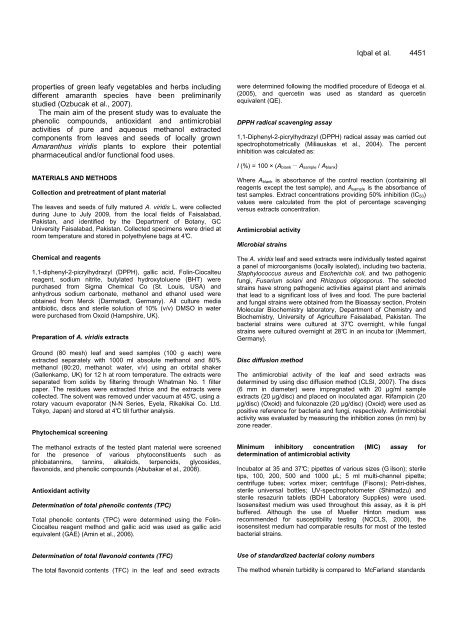Download Complete Issue (4740kb) - Academic Journals
Download Complete Issue (4740kb) - Academic Journals
Download Complete Issue (4740kb) - Academic Journals
Create successful ePaper yourself
Turn your PDF publications into a flip-book with our unique Google optimized e-Paper software.
properties of green leafy vegetables and herbs including<br />
different amaranth species have been preliminarily<br />
studied (Ozbucak et al., 2007).<br />
The main aim of the present study was to evaluate the<br />
phenolic compounds, antioxidant and antimicrobial<br />
activities of pure and aqueous methanol extracted<br />
components from leaves and seeds of locally grown<br />
Amaranthus viridis plants to explore their potential<br />
pharmaceutical and/or functional food uses.<br />
MATERIALS AND METHODS<br />
Collection and pretreatment of plant material<br />
The leaves and seeds of fully matured A. viridis L. were collected<br />
during June to July 2009, from the local fields of Faisalabad,<br />
Pakistan, and identified by the Department of Botany, GC<br />
University Faisalabad, Pakistan. Collected specimens were dried at<br />
room temperature and stored in polyethylene bags at 4°C.<br />
Chemical and reagents<br />
1,1-diphenyl-2-picrylhydrazyl (DPPH), gallic acid, Folin-Ciocalteu<br />
reagent, sodium nitrite, butylated hydroxytoluene (BHT) were<br />
purchased from Sigma Chemical Co (St. Louis, USA) and<br />
anhydrous sodium carbonate, methanol and ethanol used were<br />
obtained from Merck (Darmstadt, Germany). All culture media<br />
antibiotic, discs and sterile solution of 10% (v/v) DMSO in water<br />
were purchased from Oxoid (Hampshire, UK).<br />
Preparation of A. viridis extracts<br />
Ground (80 mesh) leaf and seed samples (100 g each) were<br />
extracted separately with 1000 ml absolute methanol and 80%<br />
methanol (80:20, methanol: water, v/v) using an orbital shaker<br />
(Gallenkamp, UK) for 12 h at room temperature. The extracts were<br />
separated from solids by filtering through Whatman No. 1 filter<br />
paper. The residues were extracted thrice and the extracts were<br />
collected. The solvent was removed under vacuum at 45°C, using a<br />
rotary vacuum evaporator (N-N Series, Eyela, Rikakikai Co. Ltd.<br />
Tokyo, Japan) and stored at 4°C till further analysis.<br />
Phytochemical screening<br />
The methanol extracts of the tested plant material were screened<br />
for the presence of various phytoconstituents such as<br />
phlobatannins, tannins, alkaloids, terpenoids, glycosides,<br />
flavonoids, and phenolic compounds (Abubakar et al., 2008).<br />
Antioxidant activity<br />
Determination of total phenolic contents (TPC)<br />
Total phenolic contents (TPC) were determined using the Folin-<br />
Ciocalteu reagent method and gallic acid was used as gallic acid<br />
equivalent (GAE) (Amin et al., 2006).<br />
Determination of total flavonoid contents (TFC)<br />
The total flavonoid contents (TFC) in the leaf and seed extracts<br />
Iqbal et al. 4451<br />
were determined following the modified procedure of Edeoga et al.<br />
(2005), and quercetin was used as standard as quercetin<br />
equivalent (QE).<br />
DPPH radical scavenging assay<br />
1,1-Diphenyl-2-picrylhydrazyl (DPPH) radical assay was carried out<br />
spectrophotometrically (Miliauskas et al., 2004). The percent<br />
inhibition was calculated as:<br />
I (%) = 100 × (Ablank __ Asample / Ablank)<br />
Where Ablank is absorbance of the control reaction (containing all<br />
reagents except the test sample), and Asample is the absorbance of<br />
test samples. Extract concentrations providing 50% inhibition (IC50)<br />
values were calculated from the plot of percentage scavenging<br />
versus extracts concentration.<br />
Antimicrobial activity<br />
Microbial strains<br />
The A. viridis leaf and seed extracts were individually tested against<br />
a panel of microorganisms (locally isolated), including two bacteria,<br />
Staphylococcus aureus and Escherichia coli, and two pathogenic<br />
fungi, Fusarium solani and Rhizopus oligosporus. The selected<br />
strains have strong pathogenic activities against plant and animals<br />
that lead to a significant loss of lives and food. The pure bacterial<br />
and fungal strains were obtained from the Bioassay section, Protein<br />
Molecular Biochemistry laboratory, Department of Chemistry and<br />
Biochemistry, University of Agriculture Faisalabad, Pakistan. The<br />
bacterial strains were cultured at 37°C overnight, w hile fungal<br />
strains were cultured overnight at 28°C in an incuba tor (Memmert,<br />
Germany).<br />
Disc diffusion method<br />
The antimicrobial activity of the leaf and seed extracts was<br />
determined by using disc diffusion method (CLSI, 2007). The discs<br />
(6 mm in diameter) were impregnated with 20 µg/ml sample<br />
extracts (20 µg/disc) and placed on inoculated agar. Rifampicin (20<br />
µg/disc) (Oxoid) and fulconazole (20 µg/disc) (Oxoid) were used as<br />
positive reference for bacteria and fungi, respectively. Antimicrobial<br />
activity was evaluated by measuring the inhibition zones (in mm) by<br />
zone reader.<br />
Minimum inhibitory concentration (MIC) assay for<br />
determination of antimicrobial activity<br />
Incubator at 35 and 37°C; pipettes of various sizes (G ilson); sterile<br />
tips, 100, 200, 500 and 1000 µL; 5 ml multi-channel pipette;<br />
centrifuge tubes; vortex mixer; centrifuge (Fisons); Petri-dishes,<br />
sterile universal bottles; UV-spectrophotometer (Shimadzu) and<br />
sterile resazurin tablets (BDH Laboratory Supplies) were used.<br />
Isosensitest medium was used throughout this assay, as it is pH<br />
buffered. Although the use of Mueller Hinton medium was<br />
recommended for susceptibility testing (NCCLS, 2000), the<br />
isosensitest medium had comparable results for most of the tested<br />
bacterial strains.<br />
Use of standardized bacterial colony numbers<br />
The method wherein turbidity is compared to McFarland standards

















